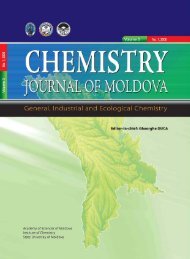2011, nr. 1 - Academia de Ştiinţe a Moldovei
2011, nr. 1 - Academia de Ştiinţe a Moldovei
2011, nr. 1 - Academia de Ştiinţe a Moldovei
You also want an ePaper? Increase the reach of your titles
YUMPU automatically turns print PDFs into web optimized ePapers that Google loves.
226<br />
hemoragia subarahnoidiană fiind în scor Hunt și<br />
Hess 4 sau 5.<br />
Printre pacienţii cu pier<strong>de</strong>re <strong>de</strong> cunoștinţă iniţială,<br />
care s-a remis până la prezentarea în spital, un<br />
număr <strong>de</strong> 20% au avut criză comiţială. În rest, aceasta<br />
a fost una tranzitorie, urmată <strong>de</strong> cefalee, vărsături și,<br />
în unele cazuri, fotofobie.<br />
La internarea în spital pacienţii au fost diagnosticaţi<br />
prin TC și, imediat, prin angio-TC. În<br />
cazurile cu angio-TC neclar, s-a practicat angiografia<br />
endovasculară Seldinger. Majoritatea pacienţilor<br />
au fost operaţi timpuriu, în primele două zile<br />
<strong>de</strong> la internare. Bolnavii cu stare gravă sau ajunși<br />
în spital la un interval mai mare <strong>de</strong> 4 zile după<br />
ruptură au fost temporizaţi pentru intervenţie întârziată.<br />
Între pacienţii cu pier<strong>de</strong>re <strong>de</strong> cunoștinţă<br />
în momentul <strong>de</strong>butului hemoragiei, care s-a remis<br />
complet în <strong>de</strong>curs <strong>de</strong> câteva minute sau câteva ore,<br />
și bolnavii fără pier<strong>de</strong>re <strong>de</strong> cunoștinţă la <strong>de</strong>but nu<br />
s-au constatat diferenţe semnificative ale parametrilor<br />
analizaţi: imagine TC cu scor Fisher, poziţia<br />
și mărimea anevrismului, intervalul <strong>de</strong> la ruptură,<br />
la intervenţie.<br />
În concluzie menţionăm că scurta pier<strong>de</strong>re<br />
<strong>de</strong> cunoștinţă la ruptura anevrismului pare să fie<br />
<strong>de</strong>terminată, în majoritatea cazurilor, <strong>de</strong> o modificare<br />
funcţională, datorată pătrun<strong>de</strong>rii bruște a<br />
sângelui în spaţiul subarahnoidian, și nu pare să<br />
influenţeze prognosticul evoluţiei cazurilor.<br />
THERAPEUTIC OPTIONS<br />
IN TEMPORAL LOBE LESIONS<br />
______________________________________<br />
I. Poeata, D. Rotariu, B. Iliescu,<br />
S. Gaivas, Z. Faiyad<br />
3 rd Neurosurgery Department,<br />
“N. Oblu” Clinical Emergency Hospital,<br />
Iasi, Romania<br />
Th e diversity of pathology aff ecting the temporal<br />
lobe and the diffi culty of surgical approaches<br />
make treating temporal lesions a challenge for<br />
mo<strong>de</strong>rn neurosurgery; however the <strong>de</strong>velopment<br />
of new therapeutic methods and advances in micro<br />
neurosurgery and collateral technology allow a better<br />
management of the temporal lesions and improve the<br />
outcome.<br />
We present a series of 88 consecutive cases with<br />
temporal lobe lesions treated in our <strong>de</strong>partment<br />
within the last 3 years (Jan. 2008 – Dec 2010), from<br />
the 88 cases inclu<strong>de</strong>d in the study, 42 were tumors,<br />
Buletinul AŞM<br />
16 cystic lesions, 13 vascular lesions which inclu<strong>de</strong>s<br />
arteriovenous malformations, arteriovenous fi stulae<br />
and cavernomas, 2 cases of cerebral abscess, and 5<br />
cases of <strong>de</strong>generative diseases.<br />
We analyze the imaging diff erential diagnosis and<br />
discuss the therapeutic options. Th e tumoral lesions<br />
were treated using microsurgical resection in 89% and<br />
the rest of 11% were treated using gamma-knife due to<br />
their location and general status, the vascular lesions<br />
were the most challenging in terms of choosing the<br />
most appropriate therapy for each particular case, in<br />
our series 61% were treated using surgery, 15% went<br />
for endovascular treatment and the remaining cases<br />
un<strong>de</strong>rwent conservatory treatment. Th e rate of surgical<br />
approach has signifi cantly <strong>de</strong>creased for the cystic<br />
pathology, just 6.2% being operated on (1 case).<br />
Conclusions. Choosing the appropriate treatment<br />
for a temporal lesion should take into account the<br />
particularities of each case (type of lesion, location,<br />
neurological and general status of the patient) the<br />
outcome being strongly related to the therapeutic<br />
option. Surgery remains the principal treatment<br />
for temporal lobe tumors, <strong>de</strong>spite its technical<br />
diffi culty, complete tumor resection being strongly<br />
recommen<strong>de</strong>d for long-term tumor control.<br />
Vascular lesions benefi t most from the new<br />
therapeutic modalities (radio surgery, vascular<br />
microsurgery and endovascular treatment), lesions<br />
which before were consi<strong>de</strong>red untreatable are now<br />
having a chance for radical treatment and good<br />
prognosis.<br />
ABORDUL ANTERIOR<br />
ÎN PATOLOGIA<br />
DEGENERATIVĂ<br />
VERTEBROMEDULARĂ<br />
CERVICALĂ.<br />
VARIANTE TEHNICE<br />
ŞI CONTROVERSE<br />
_______________________________________<br />
Ion Poeată, Cezar-Eugen Popescu,<br />
Sergiu Gaivas, Bogdan Costachescu,<br />
Bogdan Iliescu, Daniel Rotariu,<br />
Andrei Iencean<br />
Clinica <strong>de</strong> Neurochirurgie,<br />
Universitatea <strong>de</strong> Medicina și Farmacie<br />
“Gr. T. Popa”, Iaşi, România<br />
Pe un lot <strong>de</strong> 60 <strong>de</strong> pacienţi operaţi pentru hernie<br />
<strong>de</strong> disc cervicală sau stenoză <strong>de</strong> canal vertebral

















